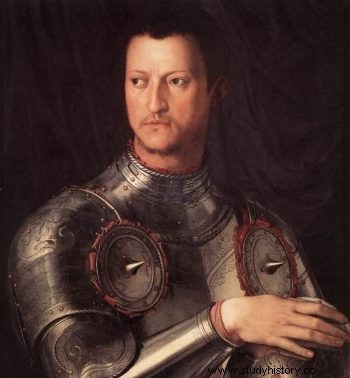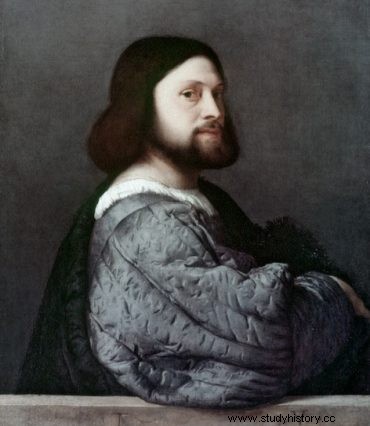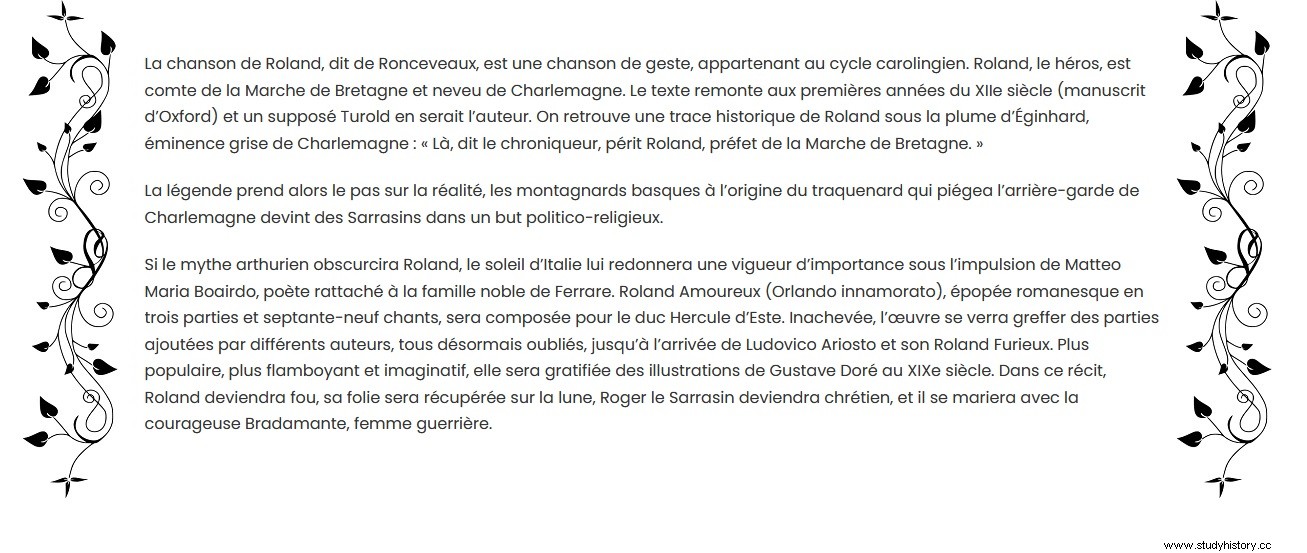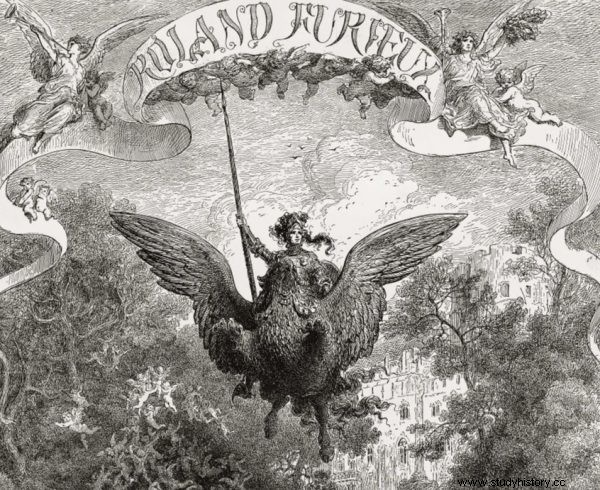At a time when the exegesis of ancient texts, scholasticism and genealogy rubbed shoulders with assiduity, it was not foolish to imagine the Greek hero Bellerophon as an ancestor, or even Hector of Troy as a distant relative. Alongside the historical figure of Alexander the Great, who was a model for princes and kings, let's talk today about this cleverly maintained complicity between the patricians of a time and their patrons. Because they needed more than a code of conduct or a mythologized story, but also to appropriate a legendary ancestry to establish an authority in troubled times.
To explain this historico-mythical contortion, let's discover how Cosimo I of Tuscany (1519-1574) teamed up with the Etruscans and the Greek hero riding Pegasus; but also the thirty long years of Ludovico Ariosto (1474-1533) to satisfy the Dukes of Este with his Roland Furieux.

(1) Cosmo I of Tuscany by Angelo Bronzino (Polo Museale Fiorentino)
Cosimo I of Tuscany was elected Duke of Florence at barely 18 years old. If we owe him a certain renovation of Florence, and especially the creation of the Uffizi Gallery and the Boboli Gardens, his warlike rides will remain his calling card. And for good reason:a two-year war against Siena will give him the opportunity to double the size of his territory. Before definitively establishing his posterity – like the bronze equestrian statue representing him – he still had to tell one last story:the direct heir to a glorious past.
At the end of the 15th century, the exhumation of Etruscan remains gave a new image of this people in the eyes of the Florentines. Archeology (which did not yet bear his name) was then certainly in its infancy but undeniably useful; a political goal was woven behind the fascination of discoveries of all kinds – from marble sculptures to jewelry from antiquity.
In 1485, in a publication, Leon Battista Alberti brought up to date a character such as Porsenna, Etruscan king of Chiusi; the latter is quoted by Livy, indicating that he inspired immense terror in the Roman Senate (Roman History II, 9).
And the Chimera of Arezzo will be living proof of this. Discovered in 1553, the ex-voto from the end of the beginning of the 4th century amazed Cosimo 1er, known as the elder. He appropriates it and exhibits it to the public in the Leon X room of the Palazzo Vecchio.

(2) Apulian red-figure dish depicting the Chimera (4th c. BC). Louvres Museum.
Because the rediscovery of Etruscan remains brings opportunities that will take shape under the pen of the Florentine chronicler Giovanni Villani. A regional dimension, in opposition to the Roman myth, will thus be born. Ultimately, the analogy of the Florentine republic with its neighboring cities will serve him well. And the autochthonous Etruria described by Dionysius of Halicarnassus in the 1st century will thus form the ideological corpus of Tuscany as the cradle of a free city.
In the “Antiquitatum variarum volumina” d'Annio da Viterbo (1437-1502), the Etruscans became the first inhabitants of the world after the flood, and even more the heirs of a Janus Hercules that Noah would have led to Tuscany. The excavations carried out in Arezzo will confirm, in addition to this desire, will be a formidable means of exposing to all the glorious return of Etruria. Montaigne, passing through Florence, would say of the work:
“I forgot that in the palace of this prince in one of the rooms there is the figure of an animal with four feet, raised in bronze on a pillar represented in the natural, of a strange shape, the front all chipped , and on the spine I don't know what form of limb, like horns. They say he was found in a mountain cave in this country, and led alive some years ago.” (Journal of Michel de Montaigne's trip to Italy)
The famous painter and architect Giorgio Vasari described Cosimo I as “Bellerophon”, in his “Ragionamenti “, which he completed in 1567.
Bellerophon was the Corinthian hero of Greek mythology who fought and killed the fantastic monster Chimera, a fearsome mixture of lion, goat and fire-breathing serpent. Son of Poseidon, Bellerophon tamed the winged horse Pegasus and fought and defeated Solymoi warriors, Amazons and Carian pirates.
Qualified as patrons, the Medici take on the role of sovereigns where politics and aesthetics are embodied in the same source, according to the Rinascita, theorized by “Les Vies”.
Etruscan becomes the cement of the Florentine language with Aramaic as a matrix. The Latin origin disappears and the very name Florence is derived from the Etruscan fir andhen , respectively flower and grace in Aramaic, which gives “flower of grace” or “graceful flower”. In fact, the name of Florence comes from the Latin “fluentia”, in reference to the confluence of the Arno and the Mugnone.
In 1569, Cosmo obtains the recognition by the Pope of the title of Grand Duke, the brief of Pius V evokes the filiation between Etruria and Tuscany. Marc-Antoine Muret, in the service of Pius V, then celebrates Cosimo as “dux Magnus hetruscus “, third in the title after Janus and Porsenna.
Twenty years later, Ferdinand presents himself even more directly as the heir of King Porsenna. The filiation, despite the lack of new archaeological finds, will persist for some time.
Convinced of its right, the title of dux Magnus hetruscus in hand, he died on August 1, 1464 at the Villa di Castello, in the last years of the Cinquecento Renaissance. Modern studies of Etruria will give another version.


(3) Painting of Ariosto by Titian (National Gallery, London)
The case of Ariosto, author of Roland Furieux (Orlando Furioso ) and his patron, Hippolyte d'Este, also makes us think about the well-established factory of legendary descendants. Far from being isolated cases, we will see that genealogical contortions loomed, even beyond Tuscany, with, among others, Philip the Good, Duke of Burgundy, and the reworked account of Perceforest.
To fully understand this relationship between Ferrara and the legend of Roland, let's briefly re-explain the contours of the different stories around the little-known historical figure of Roland, count of the Marches of Brittany:

Taking over from Matteo Maria Boiardo, dignitary of the Este court, Ludovic Ariosto's Roland Furieux was to be a consecration for Ferrara. Only 10 years after the death of Boiardo, taking up the legend around Roland and Charlemagne, and in particular Roland Amoureux, Hercule 1er d'Este will make an express request:to certify the Este lineage with the marriage of Roger de Risa and Bradamante of Clermont. The genealogy at that time had a significant weight as we specified earlier.
Moreover, the enemies of the Estes said that the lords of Ferrara were descended from the infamous traitor Ganelon of Mainz, an evil character in the legend of Roland.
When Hercule I died, his sons and successors Alphonse I and Cardinal Hippolyte did not really care about these fantasies. Nevertheless, Ariosto will continue for more than 30 years (he begins writing around 1504) finishing the Orlando Furioso.
On behalf of the cardinal, Hippolyte 1st, he will make frequent trips and embassies in Mantua, Modena, Milan, Florence. After following the brother, Alponse 1st, in the mountains of Garfagnana Estense, he returns to Ferrara, as superintendent of court spectacles. These years were exhausting and also probably enriching for the author.
Ariosto's poem focuses on two themes:Arms (Carolingian cycles) and Love (King Arthur cycle). It is dedicated to Cardinal Ippolito d'Este, its protector and patron, whose lineage, thanks to the poet, is supposed to descend from Roger, in turn a descendant of Astyanax, son of Hector of Troy and Andromache. Roger is the son of Roger II of Rise and Galicielle, daughter of King Agolant, converted for love to Christianity.

(4) Roland Furious, illustration by Gustave Doré.
“Deign to accept, generous race of Hercules, ornament and splendor of our century, Hippolyte, deign to accept what only your humble servant wants and can offer you. My words and writings alone can pay what I owe you. Do not reproach me for giving you so little, when I offer you all that it is in my power to give. Among so many heroes whose names I propose to illustrate, you will hear me speak of this Roger, your ancestor, ancient stock of your illustrious ancestors:I will tell you of his high valor and his fine deeds, if, at least, you lend your ear to me, and if your lofty thoughts lower themselves a little, to make room for my verses in the midst of them”, can we read a story intended to generously flatter the patron.
Another thief, half virgin and half demon, will come to help the genealogical destiny to be fulfilled:Merlin. The prophecies of the enchanter are formal:he will marry Bradamante so that, from their union, the Este dynasty, Dukes of Ferrara, can originate. The circle is complete:the adventures of Roland or Renaud de Montauban ended, the fate of Angélique known, the infamous Rodomont and Agramant slaughtered, the exoticism of Marphise finally converted, and of course Roger returned to the bosom of Christianity. /P>
When the poet gave the latter the first version of his poem, the cardinal, disconcerted, would have said to him:“Messire Louis, where the devil did you get all this nonsense? »
Sources and references:
Studies on the Medici by historian Caroline Callard.
Studies of the texts of Roland Furieux by Italo Calvino.
Universalis, Larousse, Geo.
Illustration of the article:Chimera of Arezzo, Archaeological Museum of Florence.
